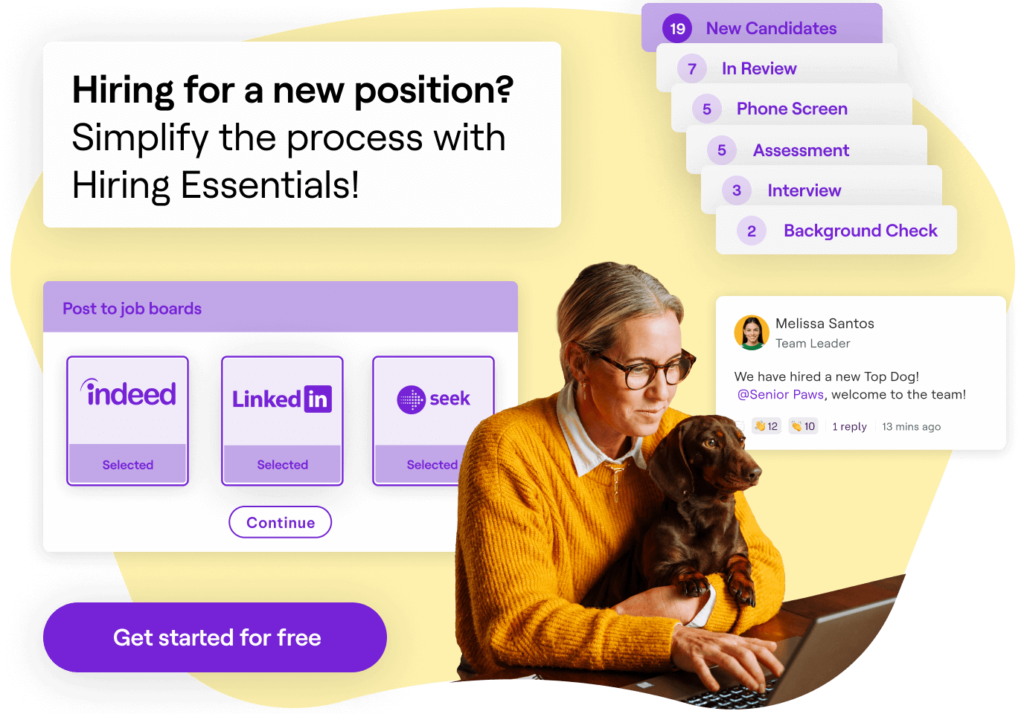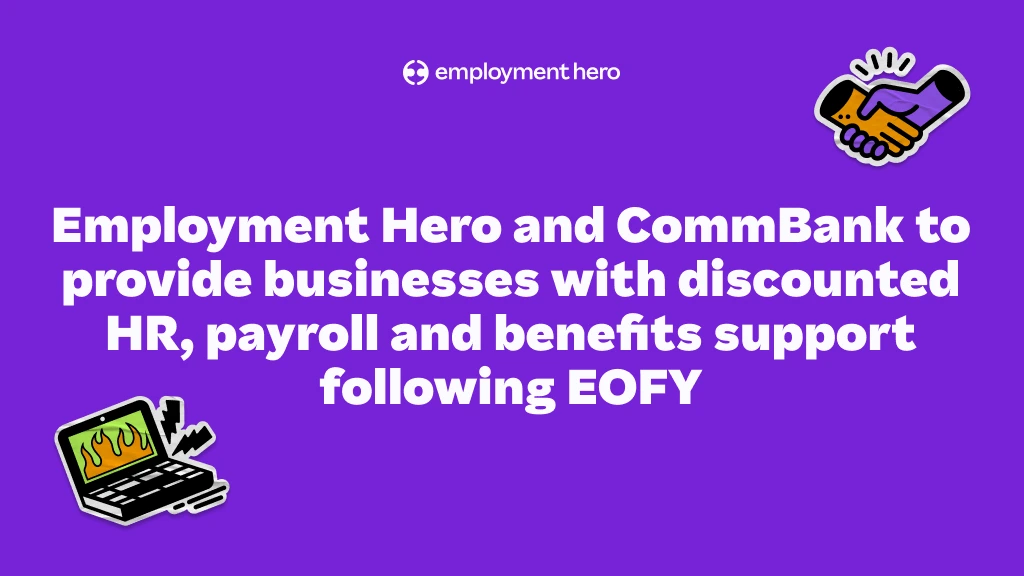How to perform a cost-benefit analysis of hiring
Deciding when to hire and how to build a business case for further recruitment

Need to increase headcount but struggling to get the green light from your senior decision makers?
Hiring new staff comes at a cost for any business, which is why senior decision makers and leadership will want to see the business case showing that hiring new employees will be beneficial (and profitable).
And yet we understand that this is a difficult process, especially if you’re a small business. For more insights, check out the comprehensive guide for small businesses on hiring new employees. It’s a challenge to deliver on performance when you’re understaffed, and the problem is made all the worse if there’s not enough budget, a low-key freeze on recruitment, or it doesn’t fit into existing headcount planning which has already been signed off.
As a leader, it can be hard to know when the right time to start hiring employees is. How do you identify the teams that require additional resources when you have limited budget allowances? Hiring is an expensive process, and as inflation continues to rise, not many businesses can afford it – let alone absorb the costs of a bad hire. Understanding the hidden costs of recruitment is also crucial in making a well-informed decision.
That’s where a cost-benefit analysis might come in handy. This is a process, or a formula, you can use to build your business case and get the all important sign off to add employees to your payroll.
It can also help you get clear on what level to recruit at, and what role you want to fill. A cost-benefit analysis weighs up the benefits a new hire can bring to the company and considers this against the costs, framing it in a way that makes it easy for your leadership team to understand and make the best decision for the business. To ensure you’re making the right choice, you might want to look into strategies for hiring the right person every time.
For senior decision makers, a cost-benefit analysis can help you decide which business areas or hires to prioritise.
What is a cost-benefit analysis in HR?
A cost-benefit analysis is a process that businesses can use to analyse decisions on a financial basis, to determine which decisions to take forward and which to reject.
When it comes to HR and hiring, a cost-benefit analysis looks at recruitment from a cost perspective, and it can be used to feed into the overall business case for making new hires or establishing a new programme such as an apprenticeship or graduate scheme.
Effectively, you’re looking to calculate the total cost of the investment to compare against the predicted return.
But be warned – this isn’t as easy as it sounds. Costs and benefits can be direct and indirect, tangible and intangible, meaning they can be very hard to quantify. But where you can, it’s well worth including in your cost-benefit analysis.
Hiring costs to consider
Hiring doesn’t come cheap. There are a number of direct and indirect costs which must be taken into consideration, not to mention intangible costs. These costs can include:
- Recruiting costs e.g. advertising and agency fees
- Training costs of a new hire, including lost production time during training, and hours invested by team members
- Wages, including benefits such as health insurance, and pensions
- Overhead costs, including office space, equipment, technology and subscriptions
- Any other unexpected costs
Tangible vs intangible benefits examples
Hiring benefits to consider
When it comes to benefits, remember that there may be tangible and intangible benefits. While this is complex when it comes to roles and personnel, the better you can quantify in terms of a monetary value, the clearer the cost-benefit analysis will be.
Benefits might look like:
- Income generation
- Increased productivity and efficiency leading to increased revenue
- The benefits associated with easing team workload, such as reduced staff turnover, reduced absenteeism, reduced stress, improved engagement and culture
- Improved customer satisfaction / reduced churn
- Improved team culture
- Capacity to grow the team and company
- Reduced freelancer costs
- Reduced overtime costs
- Improved employer brand and attracting talent
- Increased share price
Another way to consider the benefits of hiring staff is to look at the flipside – the drawbacks of not hiring more staff. These can be considerable, and might even swing a decision from senior management.
Examples might include:
- Unfinished or overrunning projects
- Reduced work quality
- Loss of revenue
- Customer complaints
- Legal claims against the business
- Negative PR
- Overworked staff, potentially leading to increased rate of injury
- Staff absenteeism
- Higher levels of burnout
- Low staff morale
Where you can quantify the costs, or missed opportunities, such as through customer satisfaction surveys, complaints, employee satisfaction or happiness survey results, this can feed into your cost-benefit analysis.
Why should you conduct a cost-benefit analysis?

Conducting cost-benefit analyses can aid swift decisions when it comes to hiring. Presenting a considered analysis of costs and benefits, framing decisions in terms of monetary value, makes it easier to demonstrate the business case for additional personnel, or what return on investment a new role or program could bring.
It can also be used to compare other choices, such as whether a different hire might be a better investment, or it could help prove the case for further team training, wellbeing programmes, or employee engagement efforts. Or, getting even more strategic, a cost-benefit analysis might reveal how a new HR system (for example) might give you an even better return on investment. Planning your HR strategy effectively can significantly contribute to your company’s long-term success.
You might also use a cost-benefit analysis to help decide whether to launch a graduate program, apprenticeship scheme, an internship, or to take on a freelancer, full time or part time new employee.
When it comes to HR, a cost-benefit analysis can be useful whenever there is a question about what course of action would be best to take.
What are the types of cost-benefit analysis?
There are different ways to conduct a cost-benefit analysis, and the technique you use will depend on what objective you’re trying to meet in bringing in your hire, and how you’ll measure whether the costs outweigh the benefit.
A very familiar term when analysing costs is ‘return on investment.’ Return on investment (ROI) is a calculation which is based on tangible numbers such as sales or revenue, conversions, and, of course, the new employee’s salary.
However, a cost-benefit analysis can also be more complex, allowing you to balance intangible considerations and provide you a wider context to use when making decisions.
So let’s take a look at three of the most common types of cost-benefit analysis.
1. Payback period
Payback period is one of the most popular types of cost-benefit analysis because it gives a very clear and easy to understand output. The formal definition of a payback period is the number of years required to recover the original cash investment. Usually this is calculated for capital investments such as machines or equipment, but it can also be useful to calculate the payback period of a senior hire, or investment in a specific team or business strategy via a new hire or program. You’re looking for how long it will take for that strategic hire to produce sufficient revenue to justify or recover the investment costs.
2. Net present value Net present value (NPV) is the difference between the present value of cash inflows and the present value of cash outflows over a period of time. NPV is used in capital budgeting and investment planning to analyse the profitability of a projected investment or project, which could be a very useful number to present to senior management when you’re looking to justify a new hire.
3. Rate of return A rate of return (RoR) is the net gain or loss of an investment over a specified time period, expressed as a percentage of the investment’s initial cost. Unlike ROI which is a simple percentage, the rate of return is framed by time, linking your return to a specific timeframe. This might be particularly useful if you’re considering a time-limited role or program, such as a six-month internship.
Six steps in the cost-benefit analysis process
1. Identify the relevant company objectives (OKRs)
The first step is to look at what objective or key result you’re trying to meet. For example, it could be about increasing revenue, and you have a specific key result to increase conversions by 10% to increase revenue. Being clear about the objective and key result will help you stay focused when analysing the relevancy or weight of the costs and benefits associated with the hire.
2. Audit workload
The next stage is to audit your current workload to understand how much work is being done in your team, how much time is being spent on specific tasks, and where the bottlenecks or opportunities lie. This will also indicate if your team is overstretched and can show where a new hire could help – but remember the gaps might not always be where you think they are. Will you need two junior team members to assist with administrative tasks, or will you require a member of leadership to help push your business strategy forward.
3. Define requirements (by role or by team)
Once you’ve gathered information on team needs, you can start to build the role. This stage presents you with an opportunity to creatively address the issue by reallocating existing resources and responsibilities before you start to define new ones. This is important because this is where you’ll start to get an idea of a budget for the role – you’ll use this later to analyse the costs and benefits.
4. Weigh up costs and benefits
Then it’s time to quantify the indirect and direct costs and benefits – see above for our guidance, or develop your own specific to your business. Each cost and benefit needs to be assigned a monetary value so that you can input it into your calculation.
5. Consider alternatives
While you’re looking at costs and benefits of a specific course of action, it’s worth going back to first principles and considering whether there is another way to achieve your objective and key result. You might be considering a graduate scheme, but could you achieve your goals with a more strategic hire first, to guide a graduate scheme at a later point in time? This is the time to look at all your options before you’re committed (or overly attached) to any specific decision.
6. Use results to build a business case
Once you’ve considered all your options, perform cost benefit analysis to decide on your preferred course of action. Then all that’s left to do is build the business case for your request – whether that’s sourcing new talent or establishing a whole new graduate programme.
Using the results of cost-benefit analysis to make an informed decision
Of course, the cost-benefit analysis is only part of your strategy when making an informed decision. You might also take into account anecdotal evidence that comes up through regular 1:1 meetings with your team. The wider context can be considered in a business case which can help convince senior leadership to sign off your request.
Mapping out tasks and activities that your team regularly carry out is a significant part of the decision making process. Having a good understanding of the workload and the time required helps clarify exactly what is needed, and also guides the seniority level required.
Of course, this also helps you understand the budget requirements too. As an alternative, you might start with a budget in mind in order to identify how many roles you have the capacity for in your business.
Whether your team is struggling to deliver on workloads or lacks strategic direction to grow with the business, mapping tasks and budgets can help build the business case for a new role or even a new team or department.
When making an informed decision, use the findings of the cost-benefit analysis and business case to think about:
- How many people you want to hire
- What you want them to do
- What experience or skill set they need to have
- What level of responsibility they will have
- What their main responsibilities will be
- What the salary (bands) will be
- Where they will fit in the company objectives
- How else these objectives could be met
For a detailed overview of recruitment and onboarding processes, you can refer to our employee recruitment process guide.
The wrap up
Figuring out what you need in terms of resources and budget is perhaps the most important part of building the business case, and will also shape the cost-benefit analysis. Whether you’re conducting a cost benefit analysis of hiring an employee or considering other strategic ways to grow your business, assigning monetary values to calculate whether the benefits outweigh the costs is a powerful tool for your hiring toolbox.
And of course, when you come to advertise for the role, you’ll have a very clear understanding of who you’re looking for and how they’ll fit into the team. When senior management sign off the budget request for the new role, good news – you’ll be ready to create your job ad and start recruiting right away.
Thinking about hiring? Get our comprehensive, no nonsense guide to recruitment.
Related Resources
-
 Read more: The ‘work-life balance’ trap: Why promising it is hurting your SME recruitment (and what to promise instead)
Read more: The ‘work-life balance’ trap: Why promising it is hurting your SME recruitment (and what to promise instead)The ‘work-life balance’ trap: Why promising it is hurting your SME recruitment (and what to promise instead)
For growing SMEs, work-life integration is a sustainable way to support your team and attract top talent. Explore how your…
-
 Read more: Job ad guide: How to attract top candidates
Read more: Job ad guide: How to attract top candidatesJob ad guide: How to attract top candidates
Looking to hire your perfect match? The way you pitch your open role can be the difference between landing or…
-
 Read more: Employment Hero and CommBank to provide businesses with discounted HR, payroll and benefits support following EOFY
Read more: Employment Hero and CommBank to provide businesses with discounted HR, payroll and benefits support following EOFYEmployment Hero and CommBank to provide businesses with discounted HR, payroll and benefits support following EOFY
Eligible CommBank Yello for Business customers will get the first 3 months free on any Employment Operating System subscription with…






















